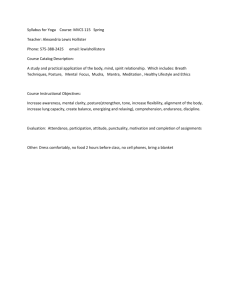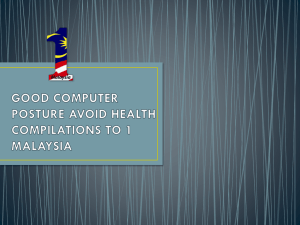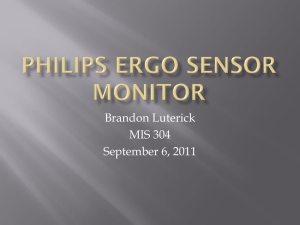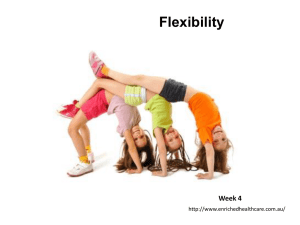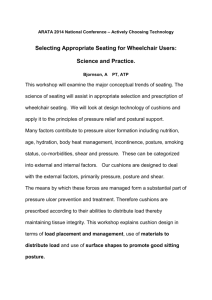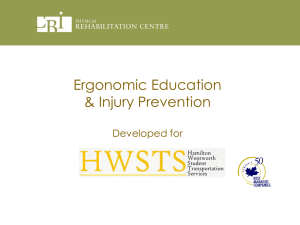The Relationship between Posture and Self-Perception
advertisement
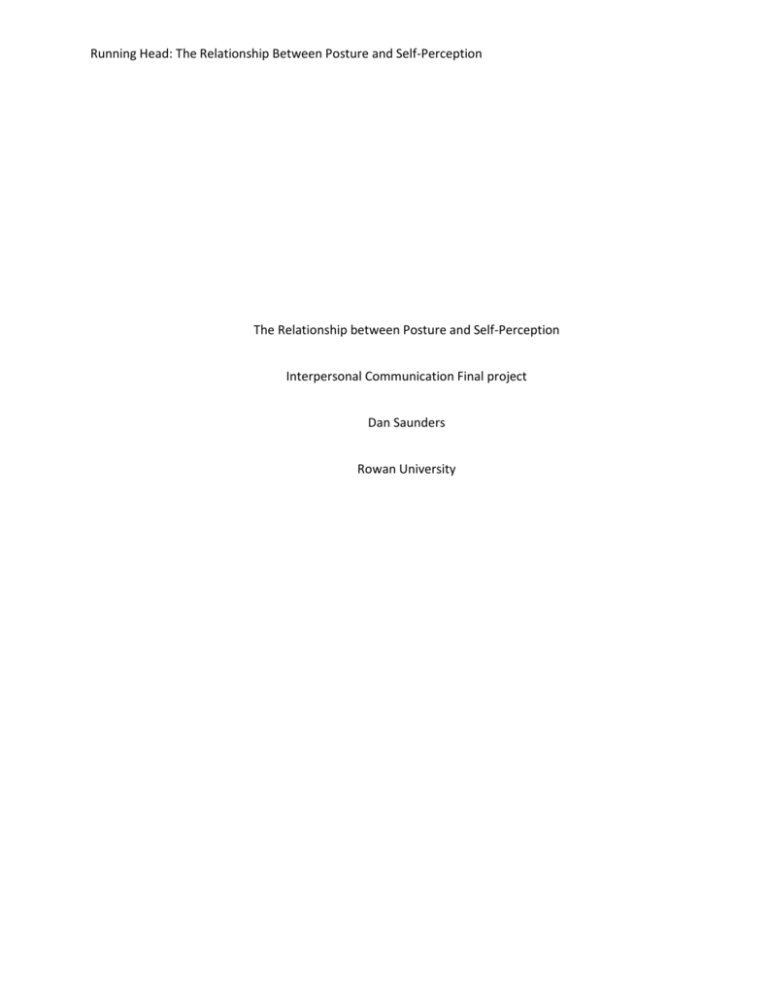
Running Head: The Relationship Between Posture and Self-Perception The Relationship between Posture and Self-Perception Interpersonal Communication Final project Dan Saunders Rowan University The Relationship Between Posture and Self-Perception Humans communicate in many different ways. We talk, text, and write daily. These are four obvious ways we communicate, but there other ways we constantly communicate in our every-day lives. The less obvious ways of communication are more natural to most of us which is why they are more difficult to realize. These ways include, but are not limited to, facial expressions, body gestures, and body appearance. Those are all forms of nonverbal communication. You may communicate solely with a simple facial expression such as a smile, but many times nonverbal communication is just an additional channel through which communication is supported. For example, you could see someone in the hall at school that you know and say “hi” while waiving and smiling, all at the same time. Right there, in that split second it took to say hi, you used three different types of communication. Two of them were nonverbal; body gesture and facial expression. So, that covers two of the three nonverbal communication types listed above, but what about the third one, body appearance? Body appearance is probably the least obvious form of communication there is, at least to the communicator. First, I will deconstruct body appearance so that it is better understood. There are two main sides to body appearance. One is what we look like. This can include how clean or dirty we are, the way we dress, whether or not we shave, and the style of hair we have. It also includes things that we cannot change in one day such as height, weight, and body build. The other side of body appearance is how we carry ourselves, in other words, our posture. Posture in terms of communication is a viscous cycle. What we think and how we feel greatly affects our posture, but studies are showing that posture also affects what we think, how we feel, and furthermore, what others think about us. Coming from a health perspective, it is kind of like the relationship between sleep and stress. The better sleep you get the less stressed you will be, but also, the more stressed you are throughout the day negatively affects the amount and quality of sleep you get at night. So when someone walks into a room with strong, tall posture, people will most likely perceive him as a strong, powerful, and confident person. This is the The Relationship Between Posture and Self-Perception communication I am referring to. He is subconsciously communicating that he has confidence and power to the people around him. A study was done where college students were asked to try and rate a new headphone. Some students were told to lie down while testing the headphones and others were told to stand up. Through the headphones a persuasive argument was played to the students. After the testing, it was found that the students who were lying down were persuaded by the message in the headphones while the students who were standing were not persuaded (Briñol, 2009). This leads to the thought that people with a tall posture are more likely to be stronger willed than those who are in a lower and more vulnerable position. The study does not prove anything, but it is a simple and clear enough idea for people to take it into account. Another study analyzed eighty-four college students. A game called cyberball was set up. Cyberball is a sort of ball game played online. Basically, students thought they were playing against other students but were really just playing against a computer. Some students were heavily included in the game. The ball would be sent to these students more frequently. Another set of students were excluded from the game. They were in the game, but the ball would be sent to them noticeably less than the students who were more heavily included. When the students were questioned after the game, they found that the included students had a difficult time holding submissive postures while the excluded students could not hold a dominant posture easily (Welker, 2013). This is yet another example of the relationship between posture and confidence. Although posture does literally affect self-perceptions, I believe that there is way more to it than that. Life is such a complex thing that we will constantly be learning more about our bodies and minds. I do not think that we will ever have life figured out completely. Not shown in these studies is how the perceptions of others towards us affect our own self perceptions. This may be even less subtle than how The Relationship Between Posture and Self-Perception our own posture affects our minds. An example is you walk into a classroom slouching, head forward, eyes on the ground, hands in pockets, and waist slightly bent. People see you and it is obvious to everyone that you are shy, timid, and weak. Because of this, you are more easily picked on or at least more excluded in daily activities. Even if people are not doing anything or thinking anything negative towards you, your perception is that they are, so you continue to be in a submissive position. There is a whole cycle going on here, as I pointed out earlier. Lack of confidence in self, causes posture to be more closed, and a closed, weak posture leads to a weakened confidence. Although confidence and posture are directly related, there is an even greater outcome to having good posture. Holding a strong, dominant, opened posture ultimately grows a leader. One particular study showed that people with a positive, upright posture sat as close to the head of the table as possible. People with poor posture tended to sit as far from the head as possible (Arnette, 2012). What better picture of a leadership position than someone who sits at the head of a table. The chairman of a board sits at the head just like the father of a household sits at the head of the dinner table. At least, this is the case with most of my past experiences. So posture does reflect how we feel and how we feel reflects our posture. We can hack our own minds by practicing good posture and performing something called power poses. Simply put, power poses are poses that open up our bodies which have been shown to improve confidence in the person doing the posing. Basically a power pose can be any position where your body is opened up to the world around it (Carney, 2010). The whole idea is to be open. Normally, people close themselves up when they are afraid, intimidated, nervous, and anything else that would be considered an antonym of confidence. Folded arms are perfect examples of closed posture. Animals use power poses as well. Think of a bear when it is trying to scare off a potential threat. The bear stands up on two legs and may even raise its arms. On the other hand, when a turtle gets The Relationship Between Posture and Self-Perception scared it closes up into its shell. Although these are extremes they are still examples of openness representing power and the closed nature representing the lack of power. Openness directly corresponds with good posture and good posture is a power pose that should be held throughout the entire day. So what is good posture? Well there are many aspects of posture. The body is a system of systems. Each body part is connected and each system works together. When discussing posture in reference to it affecting our minds, most people are referring to the shoulders back, chest forward, and neck straight position. Rounded shoulders and slouched upper back is called kyphosis and is a very common upper body postural defect. Another common postural issue is called lordosis of the cervical spine. This is when there is excessive curvature in the lower back. It is usually accompanied with tight hip flexor muscles, tight lower back muscles, week gluteus muscles, and weak abdominals. I believe that this kind of postural imbalance can affect the way you perceive yourself in the same way that kyphosis, or slouching, can. Both of those common postural problems are very much closed body positions. In Kyphosis the shoulders and arms are rotated inward and in lordosis the hips are closed and sometimes the legs are even internally rotated. Good posture is a continuous power pose. It’s all about opening yourself up and standing tall and proud. Again, confidence improves posture and posture improves confidence. It is not that easy though. The modern lifestyle is very destructive to our posture. Most people are sitting at their computer screen for hours a day and when they are not doing that they are probably sitting slouched on the couch watching television. From the time a child begins school until he graduates high school, and maybe even college, is sitting at a school desk for much of the school day. After college, many jobs require desk work. After work, people are tired and want to sit and relax. Naturally, when we sit at a desk our hips close up and back rounds forward. Our head moves forward and shoulders close The Relationship Between Posture and Self-Perception inward. Repeating this same position every day for hours a day will lead to muscle imbalances and postural defects. Postural defects cause our bodies to be closed and a closed body causes us to feel less confident and have low self-esteem. Maybe that is partially why there is so much mental illness today. There are ways to correct misaligned posture, though. Exercising weak muscles and stretching shortened muscles will restore posture over time. The best medicine, however, is prevention. If people would practice power poses and good posture on a daily basis, it’s likely that these postural problems would not arise in the first place. The study on power posing suggests that people can “fake it ’til they make it” (Carney, 2010). Simply put, the more one practices power posing and good posture, the more likely people will be to have confidence in daily life. It may be a good idea to get warmed up for an interview or speech by performing a few minutes of power posing. The best fix, however, is to have good posture permanently. Posture is a very important part of life and a powerful type of communication. It affects our minds just as our minds affect posture. Good posture will improve confidence, increase self-perception of power, and affect what people think of us, and ultimately provide the necessary attributes of a leader. Good posture can be described as shoulders back, spine straight, and head up. When a person has good posture they look open. A person with bad posture looks closed. They may have folded arms and rounded shoulders. These people tend to lack self-esteem and shy away from leadership positions. In order to be a more confident and powerful individual, good posture should be held. The Relationship Between Posture and Self-Perception References Arnette, S. L., & Pettijohn, T. F. (2012). The Effects of Posture on Self-Perceived Leadership. International Journal of Business and Social Science, 3, 1. Briñol, P., Petty, R. E., & Wagner, B. (2009). Body Posture Effects On Self-evaluation: A Self-validation Approach. European Journal of Social Psychology, 39(6), 1053-1064. Carney, D. R., Hall, J. A., & LeBeau, L. S. (2005). Beliefs About The Nonverbal Expression Of Social Power. Journal of Nonverbal Behavior, 29(2), 105-123. Carney, D. R., Cuddy, A. J., & Yap, A. J. (2010). Power Posing: Brief Nonverbal Displays Affect Neuroendocrine Levels and Risk Tolerance. Psychological Science, 1, 1. Welker, K. M., Oberleitner, D. E., Cain, S., & Carre, J. M. (2013). Upright and left out: Posture moderates the effects of social exclusion on mood and. European Journal of Social Psychology, 1, 1.
